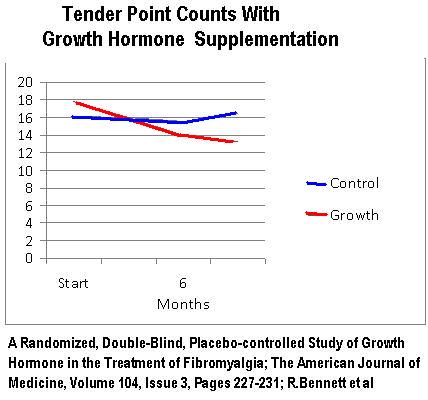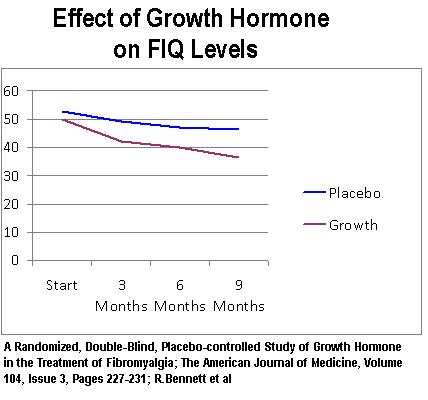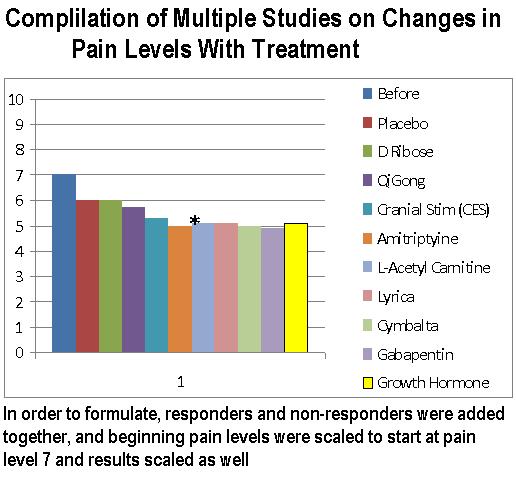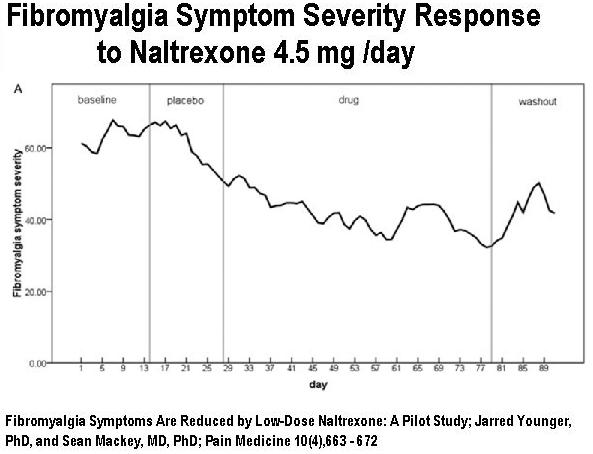A recent abstract (not article) was published finding that baseline growth hormone and peak growth hormone levels (after insulin reaction provocation) were diminished in Fibromyalgia ,but prior article attempts of growth hormone supplementation looked disappointing to me.
J Clin Endocrinol Metab. 2010 Jul 14. [Epub ahead of print]
High Prevalence of Growth Hormone Deficiency in Severe Fibromyalgia Syndromes.
Cuatrecasas G, Gonzalez MJ, Alegre C, Sesmilo G, Fernandez-Solà J, Casanueva FF, Garcia-Fructuoso F, Poca-Dias V, Izquierdo JP, Puig-Domingo M.
- Cases were restricted to SEVERE Fibromylagia, a condition known to be associated with significant brain damage. That damage in itself could throw off growth hormone regulation so growth hormone deficiency could be a result rather than a cause of FM.
- “34.2% showed IGF-I of 150 mg/liter or less.” Given it’s just an abstract , there is no discussion of normal ranges.
- “In 22 of 127 (17.3%), ITT peak GH was 5 mg/ml or less, and in eight of them (6.3%), the peak GH was 3 ng/ml or less.”
- Their conclusion is that there is “a high prevalence of GH axis dysfunction” in these cases and substitution therapy might be indicated
A trial of Growth hormone replacement was undergone in 2007:
Growth hormone as concomitant treatment in severe fibromyalgia associated with low IGF-1 serum levels. A pilot study
Guillem Cuatrecasas*1, Cristina Riudavets1, Maria Antònia Güell2 and Albert Nadal
BMC Musculoskeletal Disorders 2007, 8:119 free article here
- Saizen® 8 mg click easy, solution for injection 0.0125 mg/kg/d of r-hGH subcutaneously
- added to standard intensive therapy = amitriptyline 10–50 mg/d, fluoxetine (or other SSRI 10–
40 mg/d) and tramadol 100–400 mg/d – a very good combo of pills - Control good, was just the standard intensive therapy.
Results:

There is a FIQ – disability inventory for FM – usually differences pile up from question to question showing big differences from little change but this is what they got:

If we assume tender point counts mirror pain levels, then it was 50% better than placebo. – In most studies, placebo dropped pain levels by 1/7 so that would mean a drop of 2/7
This is a bit mediocre considering most FM measures can give you a drop of 2/7 = 28% or better – even just a herbal L-acetyl carnitine:
(for bigger view click here )

* – Amitriptyline effect not documented well after 8 weeks
Having said that, there are some things in their favor:
- Amitriptyline/ fluoxetine can drop pain levels by 2/7
- Tramadol, a painkiller they were on, can drop pains by additional 2/7
- Growth Hormone also seemed to give them an extra 2/7 decrease
However, that might be 2/7 of what is left which would be less that a plain 2/7…,
Having said that, the growth hormone would probably work on an entirely different mechanism.
It is possible the results were curtailed by the fact the worst cases were selected for study – those might be to far gone to benefit as much.
Frankly I don’t know. It costs 500-1000 dollars/month. I’d be much more likely to water exercise, try Qi gong Tai Chi and use L-acetyl carnitine:
Clin. Exp. Rheumatol. 2007 Mar-Apr;25(2):182-8.
Double-blind, multicenter trial comparing acetyl l-carnitine with placebo in the treatment of fibromyalgia patients.
Rossini M, Di Munno O, Valentini G, Bianchi G, Biasi G, Cacace E, Malesci D, La Montagna G, Viapiana O, Adami S. abstract here
See chart above – works as well – drops pain by 2/7
Another drug that may to help was Naltrexone, a pain blocker/mild painkiller used to help stop alcoholics drinking:
Fibromyalgia Symptoms Are Reduced by Low-Dose Naltrexone: A Pilot Study;
Jarred Younger, PhD, and Sean Mackey, MD, PhD;
Pain Medicine 10(4),663 – 672 free article here
Unfortunately no placebo group and based on symptom severity rather than pain level response so can’t compare to other studies well.

Naltrexone 4.5 mg is 1/10th of a 50 mg ($6.00) tablet daily – 60 cents/day is much cheaper than the growth hormone which might cost $500 – 1,000 monthly. Have tried Naltrexone and it appeared to help some.
If anyone has used growth hormone, would be interested in effects.

Terrific work! This is the type of information that should be shared around the web. Shame on the search engines for not positioning this post higher!